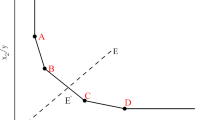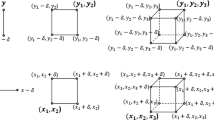Abstract
Three-way decision (3WD) is an extensively used decision theory, and it is inspired by a special way of human cognition known as thinking in three. For this reason, three-way decision has attracted the attention of many scholars. In recent years, research on the methodology and application of 3WD has been widely developed. During the decision process, decision-making units (DMUs) are usually divided as efficient and inefficient in data envelopment analysis (DEA), while the decision losses of individual DMUs are not regarded. Therefore, we introduce 3WD to DEA and propose a novel three-way DEA model to supplement the drawbacks of the traditional DEA model. First, we establish a hybrid matrix by combining the matrix of input and output indicators of DEA and the loss function table of 3WD. Afterward, a new method for obtaining the conditional probability of DMUs is presented. Next, optimistic, pessimistic and neutral strategies are developed to calculate the expected losses of three actions: acceptance, deferment and rejection. Finally, the corresponding three-way decision rules are generated. Illustrative examples are presented to demonstrate the application of our proposed model, and a series of comparative analyses are presented. Our study not only expands the application of three-way decision, but also extends the semantic interpretation of 3WD.





Similar content being viewed by others
Explore related subjects
Discover the latest articles and news from researchers in related subjects, suggested using machine learning.References
Eroglu H, Aahin R. A neutrosophic VIKOR method-based decision-making with an improved distance measure and score function: case study of selection for renewable energy alternatives. Cognit Comput. 2020;12:1338–55.
Yao YY. Three-way decisions and cognitive computing. Cognit Comput. 2016;8:543–54.
Yao YY. The geometry of three-way decision. Appl Intell. 2021;51:6298–325.
Yao YY. Tri-level thinking: models of three-way decision. Int J Mach Learn Cybern. 2020;11:947–59.
Qi J, Qian T, Wei L. The connections between three-way and classical concept lattices. Knowledge-Based Syst. 2016;91:143–51.
Singh PK. Three-way fuzzy concept lattice representation using neutrosophic set. Int J Mach Learn Cybern. 2017;8:69–79.
Yao YY. Three-way conflict analysis: Reformulations and extensions of the Pawlak model. Knowledge-Based Syst. 2019;180:26–37.
Chu XL, Sun BZ, Huang QC, Zhang Y. Preference degree-based multi-granularity sequential three-way group conflict decisions approach to the integration of TCM and Western medicine. Comput Ind Eng. 2020;143:106393.
Lang GM, Miao D, Fujita H. Three-way group conflict analysis based on pythagorean fuzzy set theory. IEEE Trans Fuzzy Syst. 2020;28:447–61.
Deng XF, Yao YY. Decision-theoretic three-way approximations of fuzzy sets. Inf Sci. 2014;279:702–15.
Qian J, Dang C, Yue X, Zhang N. Attribute reduction for sequential three-way decisions under dynamic granulation. Int J Approx Reason. 2017;85:196–216.
Zhang X, Miao D. Three-way attribute reducts. Int J Approx Reason. 2017;88:401–34.
Yao YY. Three-way decisions with probabilistic rough sets. Inf Sci. 2010;180:341–53.
Yao YY, Zhou B. Naive bayesian rough sets. RSKT 2010 Lect Notes Comput Sci. 2010.pp.719-26.
Liu D, Li TR, Liang DC. Incorporating logistic regression to decision-theoretic rough sets for classifications. Int J Approx Reason. 2014;55:197–210.
Deng XF, Yao YY. An information-theoretic interpretation of thresholds in probabilistic rough sets. RSKT 2012 Lect Notes Comput Sci. 2012.pp.369-78.
Liang DC, Liu D, Pedrycz W, Hu P. Triangular fuzzy decision-theoretic rough sets. Int J Approx Reason. 2013;54:1087–106.
Liang DC, Xu ZS, Liu D. Three-way decisions based on decision-theoretic rough sets with dual hesitant fuzzy information. Inf Sci. 2017;396:127–43.
Liu D, Li TR, Ruan D. Probabilistic model criteria with decision-theoretic rough sets. Inf Sci. 2011;181:3709–22.
Jia XY, Tang ZM, Liao WH, Shang L. On an optimization representation of decision-theoretic rough set model. Int J Approx Reason. 2014;55:156–66.
Azam N, Yao JT. Analyzing uncertainties of probabilistic rough set regions with game-theoretic rough sets. Int J Approx Reason. 2014;55:142–55.
Li HX, Zhang LB, Huang B, Zhou XZ. Sequential three-way decision and granulation for cost-sensitive face recognition. Knowledge-Based Syst. 2016;91:241–51.
Zhang HR, Min F, Shi B. Regression-based three-way recommendation. Inf Sci. 2017;378:444–61.
Liu D, Ye XQ. A matrix factorization based dynamic granularity recommendation with three-way decisions. Knowledge-Based Syst. 2020;191:105243.
Ye XQ, Liu D. An interpretable sequential three-way recommendation based on collaborative topic regression. Expert Syst Appl. 2021;168:114454.
Zhou B, Yao YY, Luo JG. Cost-sensitive three-way email spam filtering. J Intell Inf Syst. 2014;42:19–45.
Yao JT, Azam N. Web-based medical decision support systems for three-way medical decision making with game-theoretic rough sets. IEEE Trans Fuzzy Syst. 2015;23:3–15.
Liang D, Wang M, Xu Z, Chen X. Risk interval-valued three-way decisions model with regret theory and its application to project resource allocation. J Oper Res Soc. 2021;72:180–99.
Wang X, Wang B, Liu S, Li H, Wang T, Watada J. Fuzzy portfolio selection based on three-way decision and cumulative prospect theory. Int J Mach Learn Cybern. 2021; doi: 10.1007/s13042-021-01402-9.
Liu D, Yao Y, Li T. Three-way investment decisions with decision-theoretic rough sets. Int J Comput Intell Syst. 2011;4:66–74.
Li X, Huang X. A novel three-way investment decisions based on decision-theoretic rough sets with hesitant fuzzy information. Int J Fuzzy Syst. 2020;22:2708–19.
Jiang HB, Hu BQ. A novel three-way group investment decision model under intuitionistic fuzzy multi-attribute group decision-making environment. Inf Sci. 2021;569:557–81.
Jia F, Liu P De. A novel three-way decision model under multiple-criteria environment. Inf Sci. 2019;471:29–51.
Gao C, Yao Y. Actionable strategies in three-way decisions. Knowledge-Based Syst. 2017;133:141–55.
Li HX, Zhang L, Zhou X, Huang B. Cost-sensitive sequential three-way decision modeling using a deep neural network. Int J Approx Reason. 2017;85:68–78.
Charnes A, Cooper WW, Rhodes E. Measuring the efficiency of decision making units. Eur J Oper Res. 1978;2:429–44.
Cinaroglu S. Changes in hospital efficiency and size: An integrated propensity score matching with data envelopment analysis. Socioecon Plann Sci. 2021;76:100960.
Contreras I, Lozano S. Allocating additional resources to public universities. A DEA bargaining approach. Socioecon Plann Sci. 2020;71:100752.
Yang GL, Fukuyama H, Song YY. Measuring the inefficiency of Chinese research universities based on a two-stage network DEA model. J Informetr. 2018;12:10–30.
Wu MQ, Li CH, Fan JP, Wang XY, Wu ZY. Assessing the global productive efficiency of Chinese banks using the cross-efficiency interval and VIKOR. Emerg Mark Rev. 2018;34:77–86.
Torres-Ruiz A, Ravindran AR. Use of interval data envelopment analysis, goal programming and dynamic eco-efficiency assessment for sustainable supplier management. Comput Ind Eng. 2019;131:211–26.
Boudaghi E, Farzipoor Saen R. Developing a novel model of data envelopment analysis-discriminant analysis for predicting group membership of suppliers in sustainable supply chain. Comput Oper Res. 2018;89:348–59.
Yang GL, Yang JB, Liu W Bin, Li XX. Cross-efficiency aggregation in DEA models using the evidential-reasoning approach. Eur J Oper Res. 2013;231:393-404.
An QX, Meng FY, Xiong BB. Interval cross efficiency for fully ranking decision making units using DEA/AHP approach. Ann Oper Res. 2018;271:297–317.
Namazi M, Mohammadi E. Natural resource dependence and economic growth: A TOPSIS/DEA analysis of innovation efficiency. Resour Policy. 2018;59:544–52.
Rakhshan SA. Efficiency ranking of decision making units in data envelopment analysis by using TOPSIS-DEA method. J Oper Res Soc. 2017;68:906–18.
Bagherikahvarin M, De Smet Y. A ranking method based on DEA and PROMETHEE II (a rank based on DEA& PR.II). Measurement. 2016;89:333-42.
Omrani H, Amini M, Alizadeh A. An integrated group best-worst method - Data envelopment analysis approach for evaluating road safety: A case of Iran. Measurement. 2020;152:107330.
Liu D, Liang D. Three-way decisions with DEA Approach. IJCRS 2017 Lect Notes Comput Sci. 2017.pp.226-37.
Despotis DK, Smirlis YG. Data envelopment analysis with imprecise data. Eur J Oper Res. 2002;140:24–36.
Wang YM, Greatbanks R, Yang JB. Interval efficiency assessment using data envelopment analysis. Fuzzy Sets Syst. 2005;153:347–70.
Entani T, Maeda Y, Tanaka H. Dual models of interval DEA and its extension to interval data. Eur J Oper Res. 2002;136:32–45.
Jahanshahloo GR, Hosseinzadeh Lotfi F, Rostamy Malkhalifeh M, Ahadzadeh Namin M. A generalized model for data envelopment analysis with interval data. Appl Math Model. 2009;33:3237–44.
Yu Y, Zhu WW, Zhang Q. DEA cross-efficiency evaluation and ranking method based on interval data. Ann Oper Res. 2019;278:159–75.
Rouyendegh BD, Oztekin A, Ekong J, Dag A. Measuring the efficiency of hospitals: a fully-ranking DEA-FAHP approach. Ann Oper Res. 2019;278:361–78.
Puri J, Yadav SP. Intuitionistic fuzzy data envelopment analysis: An application to the banking sector in India. Expert Syst Appl. 2015;42:4982–98.
Liang DC, Xu ZS, Liu D, Wu Y. Method for three-way decisions using ideal TOPSIS solutions at Pythagorean fuzzy information. Inf Sci. 2018;435:282–95.
Ekiz MK, Tuncer Azakar C. A new DEA approach to fully rank DMUs with an application to MBA programs. Int Trans Oper Res. 2020;27:1886–910.
Liu D, Liang DC. Three-way decisions in ordered decision system. Knowledge-Based Syst. 2017;137:182–95.
Zhan JM, Jiang HB, Yao YY. Three-way multi-attribute decision-making based on outranking relations. IEEE Trans Fuzzy Syst. 2021;29:2844-58.
Ramon N, Ruiz JL, Sirvent I. Dominance relations and ranking of units by using interval number ordering with cross-efficiency intervals. J Oper Res Soc. 2014;65:1336–43.
Hongmei G, Zhihua W, Dandan J, Guoxing C, Liping J. Fuzzy evaluation on seismic behavior of reservoir dams during the 2008 Wenchuan earthquake, China. Eng Geol. 2015;197:1–10.
Wang LP, Li L, Hong NX. Entropy cross-efficiency model for decision making units with interval data. Entropy. 2016;18:358.
Wu J, Sun J Sen, Song ML, Liang L. A ranking method for DMUs with interval data based on DEA cross-efficiency evaluation and TOPSIS. J Syst Sci Syst Eng. 2013;22:191-201.
Acknowledgements
This work is partially supported by the National Science Foundation of China (Nos. 61876157, 71571148), the Science Fund for Distinguished Young Scholars of Sichuan Province (No. 22JCQN0135) and the Yanghua Scholar Plan (Part A) of SWJTU.
Author information
Authors and Affiliations
Corresponding author
Ethics declarations
Ethics Approval and Consent to Participate
This article does not contain any studies with animals performed by any of the authors.
Conflict of Interest
The authors declare that there is no conflict of interests regarding the publication of this paper.
Additional information
Publisher’s Note
Springer Nature remains neutral with regard to jurisdictional claims in published maps and institutional affiliations.
Rights and permissions
About this article
Cite this article
Chen, Q., Liu, D. & Zhang, L. Three-Way Decision Making Based on Data Envelopment Analysis with Interval Data. Cogn Comput 14, 2054–2073 (2022). https://doi.org/10.1007/s12559-021-09964-0
Received:
Accepted:
Published:
Issue Date:
DOI: https://doi.org/10.1007/s12559-021-09964-0




